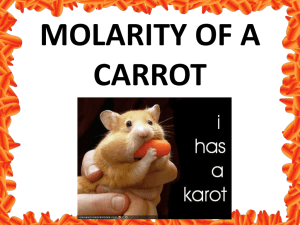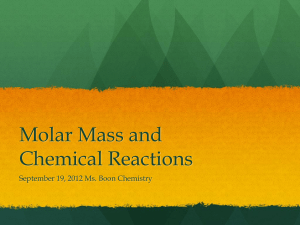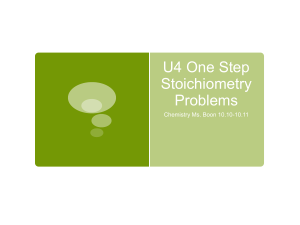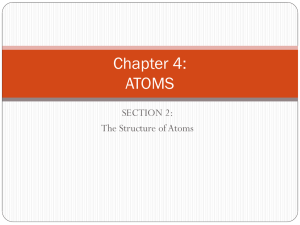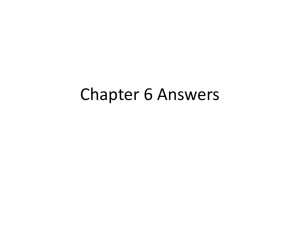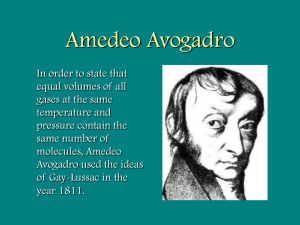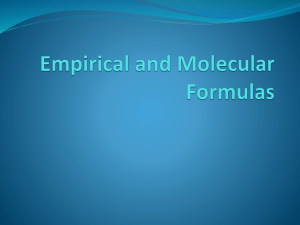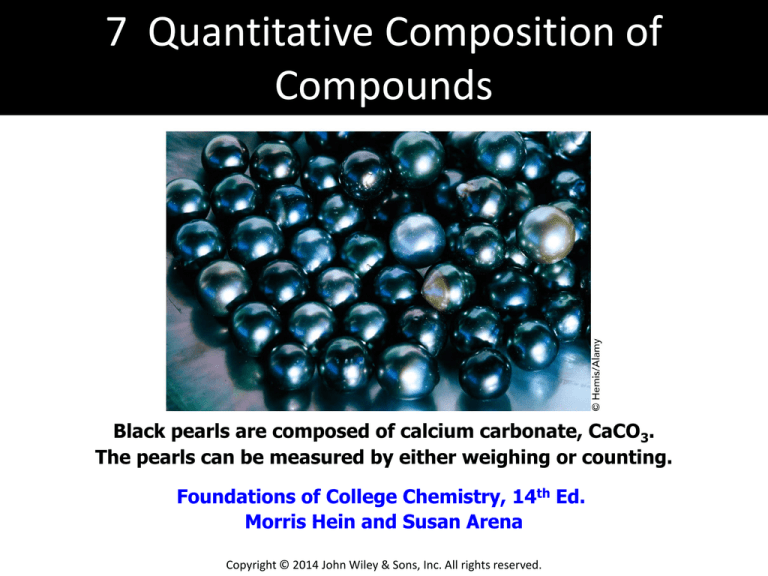
7 Quantitative Composition of
Compounds
Black pearls are composed of calcium carbonate, CaCO3.
The pearls can be measured by either weighing or counting.
Foundations of College Chemistry, 14th Ed.
Morris Hein and Susan Arena
Copyright © 2014 John Wiley & Sons, Inc. All rights reserved.
Chapter Outline
7.1 The Mole
7.2 Molar Mass of Compounds
7.3 Percent Composition of Compounds
7.4 Calculating Empirical Formulas
7.5 Calculating the Molecular Formula from the Empirical Formula
© 2014 John Wiley & Sons, Inc. All rights reserved.
The Mole
Individual atoms are tiny and have such a small mass,
more convenient units for atoms are needed to be
useful on the macroscale.
Analogy
Fruit in a supermarket is “counted” by weighing
the mass of fruit.
If the average mass for a piece of fruit is known,
the number of pieces of fruit can be calculated.
Example
If one orange has a mass of 186 g, then 75 oranges have what mass?
186 g
75 oranges ×
= 13,950 g = 13.95 kg
1 orange
Chemists count atoms in a similar way, by weighing.
© 2014 John Wiley & Sons, Inc. All rights reserved.
The Mole
The standard unit of measurement for chemistry.
1 mole = 6.022 x 1023 objects
The number represented by 1 mole, 6.022 x 1023,
is also called Avogadro’s number.
Such a large number is useful because even the smallest
amount of matter contains extremely large numbers of atoms.
The mole is similar to other common units of counting.
Example
1 dozen = 12 objects
© 2014 John Wiley & Sons, Inc. All rights reserved.
The Mole
Moles can be used to describe elements, particles
or compounds.
Mole is often abbreviated as mol.
1 mol of atoms = 6.022 x 1023 atoms
1 mol of molecules = 6.022 x 1023 molecules
1 mol of electrons = 6.022 x 1023 electrons
Avogadro’s number can be used as a conversion factor.
1 mol
6.022 x 1023 objects
6.022 x 1023 objects
1 mol
© 2014 John Wiley & Sons, Inc. All rights reserved.
The Mole
How does the mol relate to masses of elements?
The atomic mass of 1 mol of any element is defined
as the amount of that substance that contains the same
number of particles as exactly 12 g of 12C.
1 mol of any element contains the same number of atoms,
but can vary greatly in the overall mass.
(Atoms of different elements have different masses)
© 2014 John Wiley & Sons, Inc. All rights reserved.
Molar Mass
Molar Mass: the atomic mass of an element or compound
(in grams) which contains Avogadro’s number of particles.
Molar masses are expressed to 4 significant figures in the text.
Determining Molar Mass
Convert atomic mass units on the periodic table to grams
and sum the masses of the total atoms present.
Example CaF2
Molar Mass CaF2 = 40.08 g + 2(19.00) g = 78.08 g
Ca
2F
© 2014 John Wiley & Sons, Inc. All rights reserved.
Using the Mole and
Molar Mass Concepts
We can use both the mol and molar mass as
conversion factors.
How many moles of lead does 15.0 g of Pb represent?
Solution Map
g Pb
mol Pb
The conversion factor relates g of Pb to moles of Pb.
207.2 g Pb
1 mol Pb
or
1 mol Pb
207.2 g Pb
(Obtain molar mass from the periodic table.)
Calculate
1 mol Pb
= 7.24 x 10-2 mol Pb
15.0 g Pb ×
207.2 g Pb
© 2014 John Wiley & Sons, Inc. All rights reserved.
Using the Mole and
Molar Mass Concepts
How many moles of mercury does 23.0 g of Hg represent?
a. 4.62 x 103 mol Hg
b. 1.15 x 10-1 mol Hg
c. 1.15 x
101
mol Hg
d. 4.62 x
10-3
mol Hg
Solution Map
g Hg
mol Hg
The conversion factor needed:
200.6 g Hg
1 mol Hg
or
1 mol Hg
200.6 g Hg
Calculate
1 mol Hg
= 1.15 x 10-1 mol Hg
23.0 g Hg ×
200.6 g Hg
© 2014 John Wiley & Sons, Inc. All rights reserved.
Using the Mole and
Molar Mass Concepts
How many Au atoms are contained in 16.0 g of Au?
Solution Map
g Au
mol Au
atoms Au
Two conversion factors are needed:
1 mol Au
197.0 g Au
and
1 mol Au
6.022 x 1023 atoms Au
Calculate
6.022 x 1023 atoms Au
1 mol Au
×
16.0 g Au ×
197.0 g Au
1 mol Au
= 4.89 x 1022 atoms Au
© 2014 John Wiley & Sons, Inc. All rights reserved.
Using the Mole and
Molar Mass Concepts
How many Ti atoms are contained in 7.80 g of Ti?
a. 2.71 x
10-25
b. 2.25 x
1026
Solution Map
atoms Ti
atoms Ti
g Ti
mol Ti
atoms Ti
c. 9.81 x 1022 atoms Ti Two conversion factors are needed:
1 mol Ti
d. 6.20 x 10-22 atoms Ti 1 mol Ti and
6.022 x 1023 atoms Ti
47.87 g Ti
Calculate
1 mol Ti
7.80 g Ti ×
47.87 g Ti
6.022 x 1023 atoms Ti
×
1 mol Ti
= 9.81 x 1022 atoms Ti
© 2014 John Wiley & Sons, Inc. All rights reserved.
Using the Mole and
Molar Mass Concepts
What is the mass of 2.13 x 1018 atoms of Li?
Solution Map
atoms Li
mol Li
grams Li
Two conversion factors are needed:
1 mol Li
6.941 g Li
and
1 mol Li
6.022 x 1023 atoms Li
Calculate
2.13 x
1018
1 mol Li
atoms Li ×
6.022 x 1023 atoms Li
6.941 g Li
×
1 mol Li
= 2.46 x 10-5 g Li
© 2014 John Wiley & Sons, Inc. All rights reserved.
Using the Mole and
Molar Mass Concepts
What is the mass of 1.28 x 108 atoms of Ne?
a. 4.29 x 10-15 g Ne
b. 5.35 x
1032
g Ne
c. 3.06 x
10-17
g Ne
d. 1.11 x
1031
g Ne
Calculate
1.28 x
108
Solution Map
atoms Ne
mol Ne
grams Ne
Two conversion factors are needed:
1 mol Ne
1 mol Ne
and
20.18 g Ne
6.022 x 1023 atoms Ne
1 mol Ne
20.18 g Ne
atoms Ne ×
×
23
6.022 x 10 atoms Ne
1 mol Ne
= 4.29 x 10-15 g Ne
© 2014 John Wiley & Sons, Inc. All rights reserved.
Using the Mole and
Molar Mass Concepts
What is the mass of 1.05 mol of Ag?
Solution Map
mol Ag
grams Ag
One conversion factor is needed:
1 mol Ag
107.9 g Ag
Calculate
1.05 mol Ag ×
107.9 g Ag
= 113. g Ag
1 mol Ag
© 2014 John Wiley & Sons, Inc. All rights reserved.
Using the Mole and
Molar Mass Concepts
What is the mass of 8.21 mol of K?
Solution Map
a. 321. g K
b. 2.10 x
10-2
mol K
gK
grams K
One conversion factor is needed:
c. 113. g K
1 mol K
39.10 g K
d. 1.11 x 1012 g K
Calculate
8.21 mol K ×
39.10 g K
1 mol K
= 321. g K
© 2014 John Wiley & Sons, Inc. All rights reserved.
Using the Mole and
Molar Mass Concepts
How many hydrogen atoms are in
1.00 moles of H2 molecules?
Solution Map
mol H2
molecules H2
atoms H2
Two conversion factors are needed:
1 mol H2
6.022 x 1023 molecules H2
and
1 molecule H2
2 atoms H
Calculate
1.00 mol H2
6.022 x 1023 molecules H2
2 atoms H
×
×
1 molecule H2
1 mol H2
= 1.20 x 1024 atoms H2
© 2014 John Wiley & Sons, Inc. All rights reserved.
Using the Mole and
Molar Mass Concepts
How many sulfur atoms are in 2.27 mol of S8 molecules?
a. 1.33 x 10-23 atoms S8
b. 7.53 x
1022
atoms S8
mol S8
molecules S8
atoms S8
Two conversion factors are needed:
c. 4.82 x 1024 atoms S8
d. 2.08 x 10-25 atoms S8
Calculate
Solution Map
1 mol S8
1 molecule S8
and
6.022 x 1023 molecules S8
8 atoms S
6.022 x 1023 molecules S8
8 atoms S
1.00 mol S8 ×
×
1 molecule S8
1 mol S8
= 4.82 x 1024 atoms S8
© 2014 John Wiley & Sons, Inc. All rights reserved.
Molar Mass of Compounds
Much like an element,
molar mass can be defined for a compound.
Molar Mass (MM):
mass of one mole of the formula unit of a compound.
The molar mass of a compound is equal to the sum of
the molar masses of all the atoms in the molecule.
Example H2O
Molar Mass = MMO + 2MMH = 16.00 g + 2(1.008 g) = 18.02 g
© 2014 John Wiley & Sons, Inc. All rights reserved.
Molar Mass of Compounds
What is the molar mass of aluminum hydroxide, Al(OH)3?
Al(OH)3
a. 43.99 g
b. 78.00 g
c. 75.99 g
d. 46.00 g
Using the atomic masses of each element:
1 Al = 1(26.98 g) = 26.98 g
3 O = 3(16.00 g) = 48.00 g
3 H = 3(1.008 g) = 3.024 g
78.00 g
© 2014 John Wiley & Sons, Inc. All rights reserved.
Molar Mass of Compounds
The molar mass of a compound contains Avogadro’s
number of formula units/molecules.
H2
O
H 2O
2 x (6.022 x 1023)
H atoms
6.022 x 1023
O atoms
6.022 x 1023
H2O molecules
2 mol H atoms
1 mol O atoms
1 mol H2O molecules
2 x 1.008 g = 2.016 g H
16.00 g O
18.016 g H2O
Reminder: Pay close attention to whether the desired unit
involves atoms or formula units/molecules.
Example Cl2
Contains 2 mol of Cl atoms but only 1 mol of Cl2 molecules.
© 2014 John Wiley & Sons, Inc. All rights reserved.
Molar Mass of Compounds
As for elements, we can use both the mol and molar mass
of formula units/molecules as conversion factors.
How many moles of NaCl are there in 253 g of NaCl?
Solution Map
g NaCl
mol NaCl
To convert between g of NaCl and moles,
we must first calculate the molar mass of NaCl.
MM = 22.99 g + 35.45 g =
58.44 g NaCl
Calculate
1 mol NaCl
253. g NaCl ×
58.44 g NaCl
= 4.33 mol NaCl
© 2014 John Wiley & Sons, Inc. All rights reserved.
Molar Mass of Compounds
How many moles of TiCl4 are there in
12.5 g of titanium(IV) chloride?
a. 0.0659 mol TiCl4
Solution Map
b. 0.0321 mol TiCl4
g TiCl4
c. 2.37 x 103 mol TiCl4
d. 1.01 mol TiCl4
mol TiCl4
MMTiCl4 = 47.87 g + 4(35.45) g
= 189.7 g TiCl4
Calculate
12.5 g TiCl4 ×
1 mol TiCl4
= 0.0659 mol TiCl4
189.7 g TiCl4
© 2014 John Wiley & Sons, Inc. All rights reserved.
Molar Mass of Compounds
What is the mass of 3.45 mol of Li2O?
Solution Map
mol Li2O
g Li2O
To convert between mol of Li2O and g,
we must first calculate the molar mass of Li2O.
MMLi2O = 2(6.941) g + 16.00 g =
29.88 g Li2O
Calculate
3.45 mol Li2O ×
29.88 g Li2O
1 mol Li2O
= 103. g Li2O
© 2014 John Wiley & Sons, Inc. All rights reserved.
Molar Mass of Compounds
What is the mass of 1.23 mol of PH3?
a. 3.62 x 10-2 g PH3
b. 1.22 x 10-6 g PH3
c. 39.33 g PH3
d. 41.8 g PH3
Solution Map
mol PH3
g PH3
MMPH3 = 30.97 g + 3(1.008) g
= 33.99 g PH3
Calculate
33.99 g PH3
1.23 mol PH3 ×
1 mol PH3
= 41.8 g PH3
© 2014 John Wiley & Sons, Inc. All rights reserved.
Molar Mass of Compounds
How many molecules of H2S are present in 7.53 g of H2S?
How many atoms of H are present in the sample?
Solution Map g H2S
mol H2S
molecules H2S
atoms H
MMH2S = 2(1.008) g + 32.07 g = 34.09 g H2S
Calculate
1 mol H2S
7.53 g H2S ×
34.09 g H2S
×
6.022 x 1023 molecules H2S
1 mol H2S
= 1.33 x 1023 molecules H2S
1.33 x 1023 molecules H2S ×
2 atoms H
= 2.66 x 1023 atoms H
1 molecule H2S
© 2014 John Wiley & Sons, Inc. All rights reserved.
Molar Mass of Compounds
How many molecules of H2O2 are there in
0.759 g of the compound?
a. 4.29 x 10-23 molecules H2O2
b. 1.55 x 1025 molecules H2O2
c. 3.95 x
1024
molecules H2O2
g H 2O 2
Solution Map
mol H2O2
molecules H2O2
d. 1.34 x 1022 molecules H2O2
MMH2O2 = 2(1.008) g + 2(16.00) g = 34.02 g H2O2
1 mol H2O2
6.022 x 1023 molecules H2O2
0.759 g H2O2 ×
×
34.02 g H2O2
1 mol H2O2
= 1.34 x 1022 molecules H2O2
© 2014 John Wiley & Sons, Inc. All rights reserved.
Percent Composition of Compounds
Percent = parts per 100 parts
Percent composition: mass percent of each element in
a compound
Molar mass: total mass (100%) of a compound
% composition is independent of sample size
% composition can be determined by:
1. Knowing the compound’s formula or
2. Using experimental data
© 2014 John Wiley & Sons, Inc. All rights reserved.
Percent Composition from the
Compound’s Formula
Two Step Strategy
1. Calculate the molar mass of the compound.
2. Divide the total mass of each element by the
compound’s molar mass and multiply by 100.
% of the element =
Total element mass
Compound molar mass
© 2014 John Wiley & Sons, Inc. All rights reserved.
× 100
Percent Composition of Compounds
Calculate the percent composition of K2S.
Step 1 Calculate compound molar mass
MMK2S = 2(39.10) g + 32.07 g = 110.3 g
Step 2 Calculate % composition of each element.
%K=
%S=
2(39.10) g K
110.3 g
32.07 g S
110.3 g
× 100 = 70.90 % K
× 100 = 29.10 % S
Notice the sum of the percentages must equal 100%.
This provides another way of determining the %
composition of a specific element, if the other %s are known.
© 2014 John Wiley & Sons, Inc. All rights reserved.
Percent Composition of Compounds
Calculate the percent composition of O in H2O2.
a. 94.07 %
b. 5.93 %
Step 1 Calculate molar mass
MMH2O2 = 2(1.008) g + 2(16.00)g = 34.02 g
c. 88.9 %
Step 2 Calculate % composition O
d. 11.1%
2(16.00) g O
%O=
34.02 g
× 100 = 94.07 % O
© 2014 John Wiley & Sons, Inc. All rights reserved.
Percent Composition of Compounds
Calculate the % composition of K2CrO4.
Step 1 Calculate compound molar mass
MMK2CrO4 = 2(39.10) g + 52.00 g + 4(16.00) g = 194.2 g
Step 2 Calculate % composition
%K=
% Cr =
%O=
2(39.10) g K
194.2 g
52.00 g Cr
194.2 g
4(16.00) g O
194.2 g
× 100 = 40.27 % K
× 100 = 26.78 % Cr
× 100 = 32.95 % O
© 2014 John Wiley & Sons, Inc. All rights reserved.
Percent Composition from
Experimental Data
Two Step Strategy
1. Calculate the mass of the compound formed.
2. Divide the mass of each element by the total mass and
multiply by 100.
% of the element =
Total element mass
Total compound mass
© 2014 John Wiley & Sons, Inc. All rights reserved.
× 100
Percent Composition from
Experimental Data
When heated in air, 1.63 g of Zn reacts with
0.40 g of oxygen to give ZnO. Calculate the percent
composition of the compound formed.
Step 1 Calculate the mass of the compound formed.
Mass compound = MassZn + MassO = 1.63 g + 0.40 g
= 2.03 g compound
Step 2 Calculate % composition
% Zn =
%O=
1.63 g Zn
2.03 g
0.40 g O
2.03 g
× 100 = 80.3 % Zn
× 100 = 20. % O
100.3%
Total should be +/0.5% of 100
© 2014 John Wiley & Sons, Inc. All rights reserved.
Percent Composition from
Experimental Data
Aluminum chloride forms by reaction of
13.43 g of Al with 53.18 g of chlorine.
What is the percent composition of Cl in the compound?
a. 53.2 % Step 1 Calculate the mass of the compound
formed.
b. 79.8 %
Mass compound = MassAl + MassCl
c. 20.2 %
= 13.43 g + 53.18 g = 66.61 g compound
d. 46.8 % Step 2 Calculate % composition
% Cl =
53.18 g Cl
66.61 g
× 100 = 79.8 %
© 2014 John Wiley & Sons, Inc. All rights reserved.
Empirical and Molecular Formula
Empirical Formula: smallest whole number ratio of atoms
in a compound
Molecular Formula: actual formula of a compound.
Represents the total number of atoms
in one formula unit of the compound.
Whole number multiple of the empirical formula
Example
Acetylene (C2H2)
and
Benzene (C6H6)
Both have the same empirical formula CH.
Each compound is a multiple of CH.
Acetylene C2H2 = (CH)2
Benzene C6H6 = (CH)6
© 2014 John Wiley & Sons, Inc. All rights reserved.
Empirical and Molecular Formula
Formula
Composition
%C
%H
Molar Mass
(g/mol)
CH (empirical formula)
92.3
7.7
13.02
C2H2 (acetylene)
92.3
7.7
26.04 (2 x 13.02)
C6H6(benzene)
92.3
7.7
78.16 (6 x 13.02)
Each compound has very different chemical and
physical properties even though they share
the same empirical formula.
Compounds with the same empirical formula have the
same percent composition.
Molar mass = molar mass of the empirical unit ×
multiple of the unit
© 2014 John Wiley & Sons, Inc. All rights reserved.
Calculating Empirical Formulas
To calculate an empirical formula, you need to know:
1. The elements present in the compound
2. The atomic masses of each element
(from the Periodic Table)
3. The ratio (by mass or %) of the combined elements
© 2014 John Wiley & Sons, Inc. All rights reserved.
Calculating Empirical Formulas
Strategy to Calculate an Empirical Formula:
1. Assume a starting mass of the compound (usually
100.0 g) and express the mass of each element in grams.
2. Convert g of each element to mol using molar mass.
(These numbers may or may not be whole numbers.)
3. Divide each of the mole amounts from Step 2 by the
smallest mole amount. The new numbers are the
subscripts in the empirical formula.
Special Case:
If fractions are encountered, multiply by a common factor
to provide whole numbers for each subscript.
© 2014 John Wiley & Sons, Inc. All rights reserved.
Calculating Empirical Formulas
Calculate the empirical formula for a compound that
contains 11.19% H and 88.79% O.
Step 1 Find amounts of each element
In a 100.0 g sample, there are
11.19 g H and 88.79 g O
Step 2 Convert g to moles using element molar masses
11.19 g H ×
1 mol H
1.008 g H
= 11.10 mol H
88.79 g O ×
1 mol O
16.00 g O
= 5.549 mol O
© 2014 John Wiley & Sons, Inc. All rights reserved.
Calculating Empirical Formulas
Step 3 Convert to whole numbers by dividing by the
smallest mole amount.
11.10 mol H
5.549 mol O
= 2.000
5.549 mol O
5.549 mol O
= 1.000
Empirical formula is H2O
© 2014 John Wiley & Sons, Inc. All rights reserved.
Calculating Empirical Formulas
Calculate the empirical formula for a compound that
contains 56.68% K, 8.68% C and 34.73% O.
a. K3C2O3
b. K4C2O6
c. K2CO3
d. KCO2
Step 1 Find amounts of each element
In a 100.0 g sample, there are
56.68 g K, 8.68 g C and 34.73 g O
Step 2 Convert g to moles
56.69 g K ×
8.68 g C
×
34.73 g O ×
1 mol K
39.10 g K
1 mol C
12.01 g C
1 mol O
16.00 g O
= 1.447 mol K
= 0.723 mol C
= 2.171 mol O
© 2014 John Wiley & Sons, Inc. All rights reserved.
Calculating Empirical Formulas
Calculate the empirical formula for a compound that
contains 56.68% K, 8.68% C and 34.73% O.
Step 3 Convert to whole numbers by dividing by the
smallest mole amount.
a. K3C2O3
b. K4C2O6
c. K2CO3
d. KCO2
1.447 mol K
= 2.000
0.723 mol
0.723 mol C
= 1.000
0.723 mol
2.171 mol O
= 3.000
0.723 mol
Empirical formula is: K2CO3
© 2014 John Wiley & Sons, Inc. All rights reserved.
Calculating Empirical Formulas
Calculate the empirical formula for a compound that
contains 2.233 g Fe and 1.926 g S?
a. FeS2
Step 1 Find amounts of each element
b.Fe3S2
Already provided in problem
2.233 g Fe and 1.926 S
c. FeS
d. Fe2S3
Step 2 Convert g to moles
2.233 g Fe
1.926 g S
×
1 mol Fe
55.85 g Fe
= 0.03998 mol Fe
×
1 mol S
32.07 g S
= 0.06006 mol S
© 2014 John Wiley & Sons, Inc. All rights reserved.
Calculating Empirical Formulas
Step 3 Convert to whole numbers by dividing by the
smallest mole amount.
Common Fractions
0.03998 mol Fe
Decimal
Fraction
= 1.000 × 2 = 2.000
0.03998 mol
0.25
1/4
0.06006 mol S
0.03998 mol
= 1.502 × 2 = 3.000
Empirical formula is Fe2S3
0.33…
1/3
0.5
1/2
0.66….
2/3
0.75
3/4
To get a whole number, multiply the decimal by the
corresponding number in the denominator of the fraction.
Example After dividing, you get 0.75 (=3/4)
Multiply by the denominator 4(0.75) = 4(3/4) = 3
© 2014 John Wiley & Sons, Inc. All rights reserved.
Calculating the Molecular Formula from
the Empirical Formula
If molar mass is known, the molecular formula can be
calculated from the empirical formula.
Molecular formula is a multiple of the empirical formula.
Need to determine the value of n.
Solving for n
n =
Molar mass
= number of empirical units
Mass of empirical formula
in the molecular formula
© 2014 John Wiley & Sons, Inc. All rights reserved.
Calculating the Molecular Formula from
the Empirical Formula
The molecular formula can be calculated from the
empirical formula if the compound’s molar mass is known.
Molecular formula = multiple of the empirical formula
(EF)n = MF
Determining the multiple n gives the molecular formula
n =
Molar mass
= number of empirical units
Mass of empirical formula
in the molecular formula
© 2014 John Wiley & Sons, Inc. All rights reserved.
Calculating the Molecular Formula from
the Empirical Formula
A compound with the empirical formula NH2
was found to have a molar mass of 32.05 g.
What is the molecular formula?
n =
Molar mass
= number of empirical units
Mass of empirical formula
in the molecular formula
n =
32.05
14.01 + 2(1.008)
= 2
Molecular formula = (NH2)2 = N2H4
© 2014 John Wiley & Sons, Inc. All rights reserved.
Calculating the Molecular Formula from
the Empirical Formula
A compound with the empirical formula NO2 was found
to have a molar mass of 92.00 g. What is the molecular
formula?
a) NO2
b)N2O4
n =
92.00 g
14.01 + 2(16.00) g
= 2
c) N3O6
d) N4O8
Molecular formula = (NO2)2 = N2O4
© 2014 John Wiley & Sons, Inc. All rights reserved.
Calculating the Molecular Formula from
the Empirical Formula
Propylene contains 14.3 % H and 85.7 % C and has a
molar mass of 42.08 g. What is its molecular formula?
Plan Calculate empirical formula and then determine the
molecular formula
Step 1 Find compound masses
In 100.0 g of compound, 14.3 g H and 85.7 g C
Step 2 Convert g to moles
1 mol H
= 14.2 mol H
14.3 g H ×
1.008 g H
1 mol C
= 7.14 mol C
85.7 g C ×
12.01 g C
© 2014 John Wiley & Sons, Inc. All rights reserved.
Calculating the Molecular Formula from
the Empirical Formula
Step 3 Convert to whole numbers by dividing by the
smallest mole amount.
14.2 mol H
= 1.99
7.14 mol
7.14 mol C
= 1.00
7.14 mol
Empirical formula = CH2
With EF, calculate the molecular formula
n =
42.08 g
12.01 + 2(1.008) g
= 3
Molecular formula = (CH2)3 = C3H6
© 2014 John Wiley & Sons, Inc. All rights reserved.
Calculating the Molecular Formula from
the Empirical Formula
Calculate the molecular formula for a compound that
contains 80.0% C and 20.0% H with a molar mass of 30.00 g.
a. CH3
b. CH2
c. C2H6
d. C2H4
Plan Calculate empirical and then
molecular formula
Step 1 Find compound masses
In 100.0 g of compound, 20.0 g H and 80.0 g C
Step 2 Convert g to moles
1 mol H
20.0 g H ×
1.008 g H
80.0 g C
×
1 mol C
12.01 g C
© 2014 John Wiley & Sons, Inc. All rights reserved.
= 19.8 mol H
= 6.66 mol C
Calculating the Molecular Formula from
the Empirical Formula
Step 3 Convert to whole numbers by dividing by the
smallest mole amount.
19.8 mol H
= 2.97
6.66 mol
6.66 mol C
= 1.00
6.66 mol
Empirical formula = CH3
From empirical formula, calculate the molecular formula
n =
30.00 g
12.01 + 3(1.008) g
= 2
Molecular formula = (CH3)2 = C2H6
© 2014 John Wiley & Sons, Inc. All rights reserved.
Learning Objectives
7.1 The Mole
Apply the concept of the mole, molar mass,
and Avogadro’s number to solve chemistry problems.
7.2 Molar Mass of Compounds
Calculate the molar mass of a compound.
7.3 Percent Composition of Compounds
Calculate the percent composition of a compound from
its chemical composition and from experimental data.
© 2014 John Wiley & Sons, Inc. All rights reserved.
Learning Objectives
7.4 Calculating Empirical Formulas
Determine the empirical formula for a compound
from its percent composition.
7.5 Calculating the Molecular Formula
from the Empirical Formula
Compare an empirical formula to a molecular formula
and calculate a molecular formula from an
empirical formula, using the molar mass.
© 2014 John Wiley & Sons, Inc. All rights reserved.


